

Last updated: 10/23/2023


Fred's Classic ABU Reel Information
Fred Ribb
All information on this page is my interpretation and opinion about the history of the Ambassadeur reel as I understand it. Please contact me about inaccuracies and they will be promptly addressed and corrected when verified.
If you have any questions, need an appraisal, or wish help with your reel or have additional information, you can reach me at this address: f_ribb@centex.net
Table of Contents (Click on links)
5000 De Luxe #223: Where Have You Been?
INTRODUCTION
My name is Fred and I've collected Ambassadeur reels since late 1994. My introduction to collecting tackle started with lures and quickly spread to reels. As a young boy, my father frequently took me fishing. In the 1960s and 70s, Galveston, Texas was where my family spent its free time. One of my father’s favorite reels was the Ambassadeur 6000. I used a Mitchell 300 until I was about thirteen or fourteen, when my father decided it was time for me to take the next step-- an Ambassadeur 5000! From then on, it would be an Ambassadeur that went on all my fishing trips. In 1995, about the time I realized I wanted to collect these reels seriously, I met Simon Shimomura at the Houston, Texas NFLCC show. He was very kind to me as he explained what was wrong with a 5000 I found in the field. It was a mutt! It had the wrong style handle, wrong type pillar screws for that year’s model, and so on. That's the day I knew if I wanted to collect them, I had to learn about them. During all my years of collecting, Simon has been the biggest influence in my collecting life and I wish to thank him for that very much. We have become good friends through time and he will always be close to my heart.
![]() CLICK TO ENLARGE MOST PICTURES ON THIS WEB PAGE!
CLICK TO ENLARGE MOST PICTURES ON THIS WEB PAGE!
Below can be found information, but not limited to, dating reels, reel cases, model number and letter designations, warning signs of altered reels, version numbers and their meaning. It is my hope that this information can be used as a tool to avoid some of the pitfalls associated with collecting.
I have also included some cleaning tips that I've learned over the years which I believe are helpful to know. One may be surprised at just how good Grandpa's old reel will look when it has been properly cleaned. Email me with questions and I'll be glad to help you.
Let me make one quick point for the new collectors reading this. One will often hear the terms 3-screw and 4-screw in reference to the Ambassadeur reels. What is meant is very simple. As one looks at the endplate opposite the handle, the reel will either have 3 or 4 screws. There is one exception to this statement. The ABU 3000 and Ambassadeur 4000 have 4 screws on the left side but are not considered by collectors as a 4-screw model. Their construction is quite different than their counterparts and were never changed to a 3-screw model. The conversion to 3-screw took place in January 1968.
5000 DE LUXE #223: WHERE HAVE YOU BEEN?
Can you ever recall seeing a 5000 De Luxe stamped with serial number #11 through #231? Chances are, you have not. This has been one of the great mysteries surrounding this model ever since its introduction in 1962. Simon Shimomura, author of three books on collectible Ambassadeur reels has sought for 20 years to find a single example of these missing serial numbers without success.
On September 7, 2013, a gentleman contacted me with pictures of his 5000 De Luxe with serial number #223. To my knowledge, no one has ever stepped forward with confirmation of a 5000 De Luxe carrying a serial number larger than #10 but smaller than #232.
Here's an excerpt taken from Simon's latest book, The Mystique of Ambassadeur, Its Unexplored Stories. Simon is referring to ABU's record book (register) where serial number information is recorded for the various models ABU produced.
"Production and shipping record for this model starts with serial number #232. There is no previous numbers entered into the record book. The very first entry to the book was 0232~0352 to G and there was nothing before. 0232 stands for #232 and G stands for Garcia where item was shipped. It was not that #1~#231 were missing from the entry, it was that the first number of the book was prestamped from 0232."
"Incidentally, ABU has missed a lot of entries into the record book of production for other models but this is not one of those cases. There simply is no room or page spared to enter numbers 1~231."
Simon owns #1, #3, #7 and #10. It is confirmed that multiple 5000 De Luxe carrying serial numbers #1~#10 have been found. This raises the question, could ABU have produced 231 units with serial numbers ranging from #1~#10? We don't know the answer to that because it would be impossible to verify. Each individual item would have to carry its own identifying mark so as not to count it twice.
The discovery of #223 leaves us with more questions. Now that it has surfaced, where are the other 221 items? Are there in fact, another 221 individual items with sequential numbers between #11~#231? If so, why were these serial numbers not recorded in ABU's register? As Simon stated earlier, "There simply is no room or page spared to enter numbers 1~231." The mystery continues and I encourage anyone who has a 5000 De Luxe with serial number #11 through #231 to please contact me or Simon Shimomura so that we can create a file on these extremely illusive serial numbers that have been missing for 51 years! (Note: The following 3 pictures of the #223 reel are courtesy of Cameron Park Angler Steve Oliver!)
UNKNOWN 5000C DE LUXE 4-SCREW DISCOVERY
This is a very rare 5000C De Luxe 4-screw model. It certainly deserves the title as one of the hardest to find, much like the Record Ambassadeur 5000 anodized in green, Record Ambassadeur 5000 anodized in black and the left hand retrieve 5001C with grooved rims. In the Fall of 2009, as I was looking at reels on ebay, I came across a 5000C De Luxe. When I first viewed the reel I sat up in my chair and took note. This reel had a 4-screw frame. I quickly grabbed Simon's book and checked to see if this reel was listed and as I thought, it was not. Only the 3-screw version was included.
I was intrigued by the reel because the handle nut was the second style round top with oil port and this was thought to never be offered on the 5000C De Luxe. The earliest handle nut version for this model would have a round top and "oil" stamped once on it. When I checked the serial number on the reel, that's when I knew something very unusual may be in the works. I've been recording serial numbers on different models for quite some time now and this was the lowest number I had ever seen for 5000C De Luxe.
Not wanting to disturb Simon yet, I kept the listing to myself until a few days later when another one comes to auction which is the one pictured here. This reel is identical in every way to the one I had been watching. The serial number on this reel is extremely close to the first one I found. This is when I contacted Simon with my information and pictures. He wrote back to me and said I may have made a great new discovery!
Simon searched through his spread sheet of serial numbers for 5000C De Luxe and 5000 De Luxe models. I gave him some of my confirmed serial numbers as well. After a careful evaluation of each unit including the paperwork and box for one of the reels, it was confirmed that the frames’ serial numbers were those of the soon-to-be discontinued 5000 De Luxe model as the new 5000C De Luxe were in the earliest stage of production. Simon told me that never had he considered this reel to exist. Simon and I know many of the serial numbers leading up to the end of production for the 5000 De Luxe. I can confirm some of the earliest known serial numbers belonging to the 3-screw version of 5000C De Luxe models. There is a small grouping of serial numbers that belong to the 4-screw 5000C De Luxe version, making it nearly impossible to assemble this reel without knowing which numbers fit.
As of February 2020, there are only forty units known by me to exist. Could there be more? There is the possibility but production numbers should be low. I need the public to come forward with other examples so I can confirm the serial number and the various parts assembled, as original.
Simon has given me credit to discovering this reel and it's mentioned in his biography published in Japanese in 2010 and his latest book titled The Mystique of Ambassadeur, Its Unexplored Stories published in December 2011 in both English and Japanese.
This was a great moment for me. I wouldn't have discovered this reel if it hadn't been for Simon Shimomura's dedication to the Ambassadeur and his books which are so inspiring. If you have a 4-screw 5000C De Luxe please contact me so I can continue my research on them.
This rare beauty is owned by my dear friend Billy Taylor who also collects Ambassadeur.
This stunning 5000C De Luxe is owned by Billy Taylor and is unequaled in both beauty and Ambassadeur history.
TRANSITION FROM DE LUXE TO C DE LUXE
Attention must be given to the counter-balance handle seen in the upper right hand corner of the schematic. Part #9219 is described in the parts section as an (accessory.) Part #9200 seen in the lower middle portion of the schematic is described as a drag conversion kit and can be purchased separately. Both parts are added to the schematic by Garcia and not by ABU. 5000 De Luxe was never delivered with a counter-balance handle (#9219), only the small twin knob type.(#5179DL)
I'll attempt to show pictures in chronological order that led up to the rare 4-screw version of 5000CDL. First picture is from my personal collection showing 5000 De Luxe with serial number 8097. This example was made in 1968. There is no friction washer installed which is typical for this model.
5000 De Luxe with serial number 9995. This is getting close to the 5 digit mark of 10000 where this model will soon be discontinued. Look closely and you can see a piece of the friction washer potruding between the handle and star drag.
5000 De Luxe with a very low 5 digit number of 10061. Again, look closely and you will see the friction washer as shown in the 1969 parts schematic for this model.
This is the earliest known 5000C De Luxe that I'm aware of. It has the lowest serial number of any 5000CDL found to date. This reel was found by a gentleman in Texas that contacted me for more information. After our conversation, he sent the reel to me for inspection and cleaning. The reel is 100% original from the factory and matches the 1971 Napp och Nytt advertisement quite well. Note that the reel carries the friction washer which ties it to the 1969 schematic for 5000 De Luxe. Serial numbers are being mixed as both models are being made at this point. Transition is now in full swing.
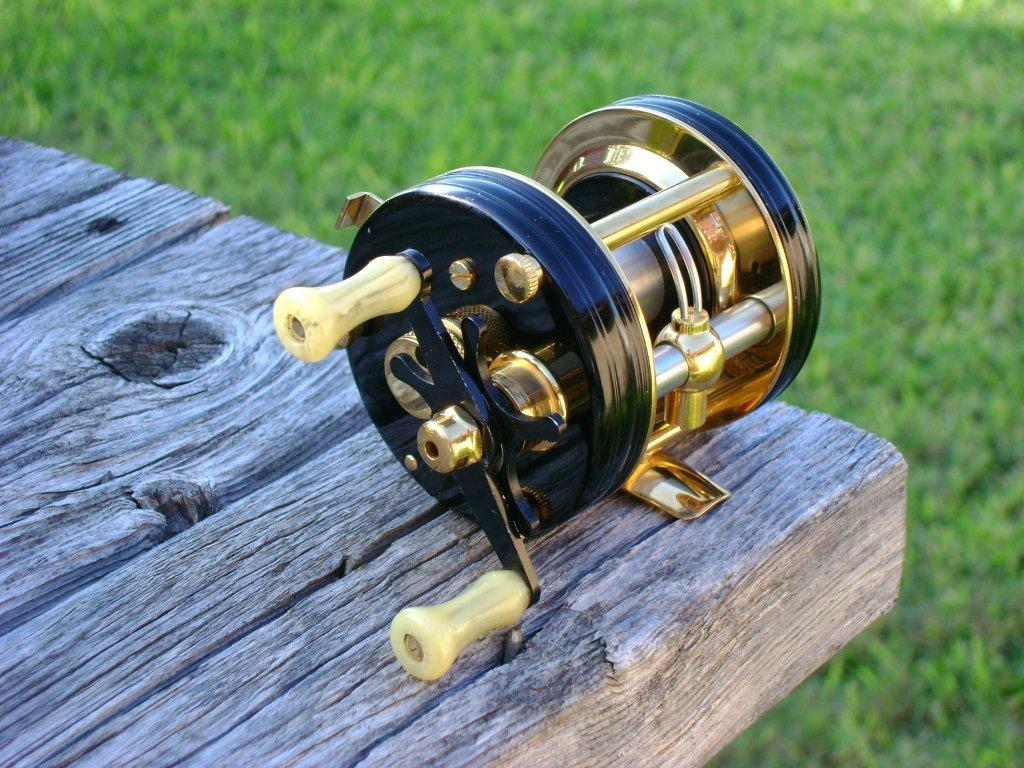
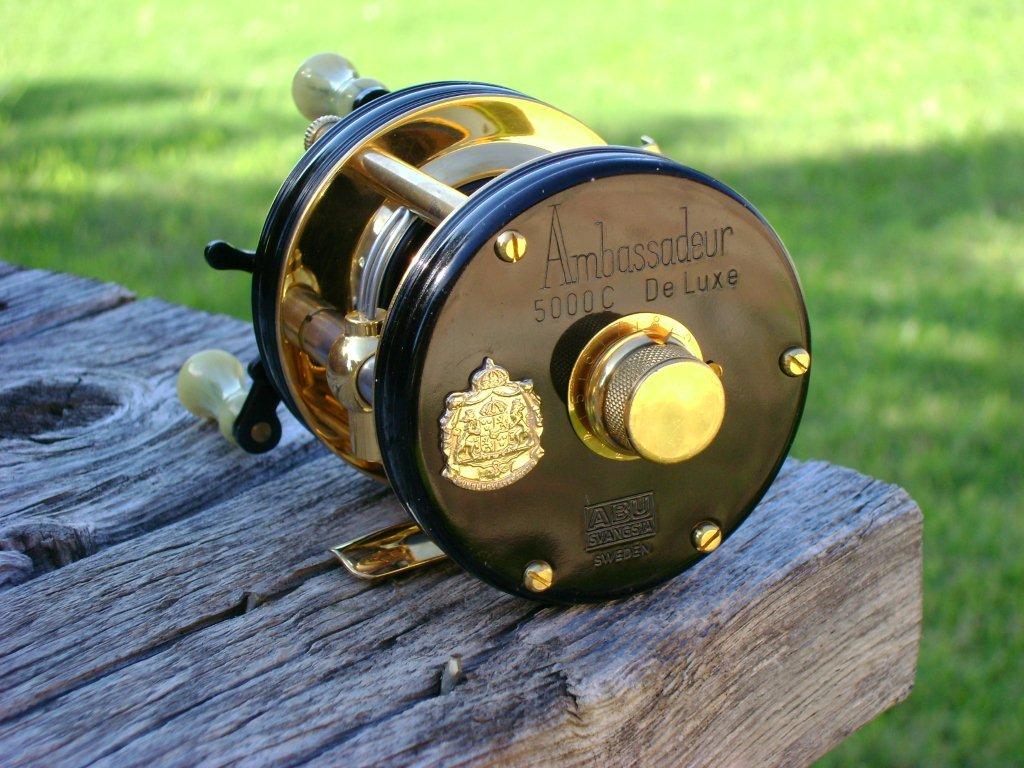
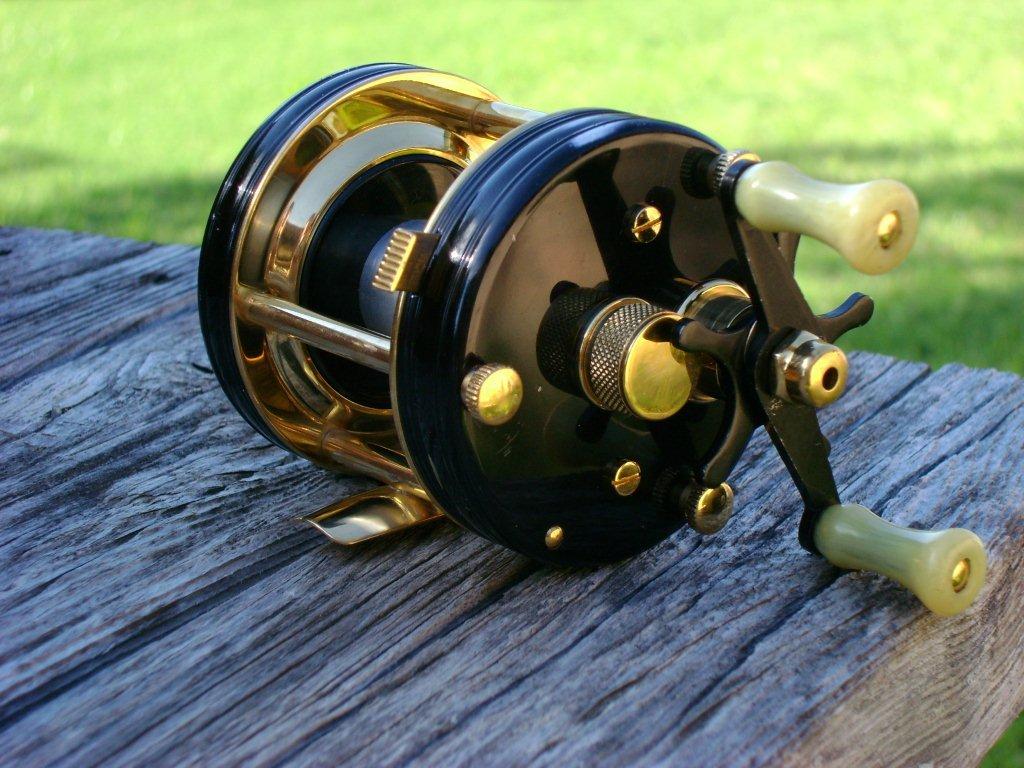
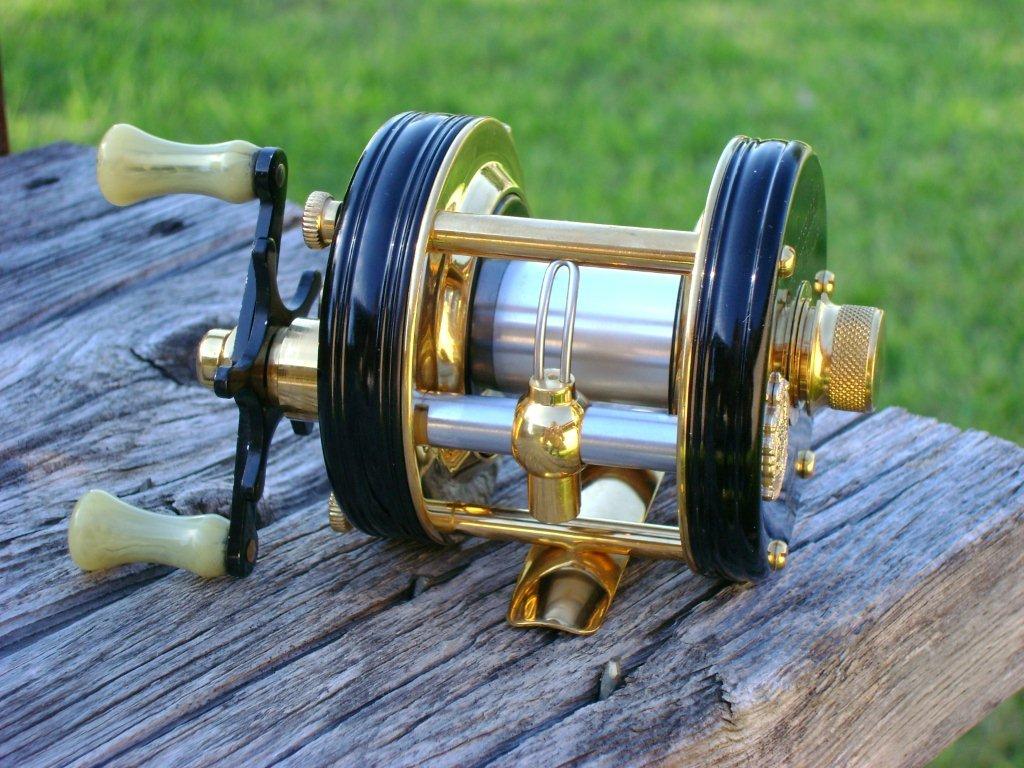
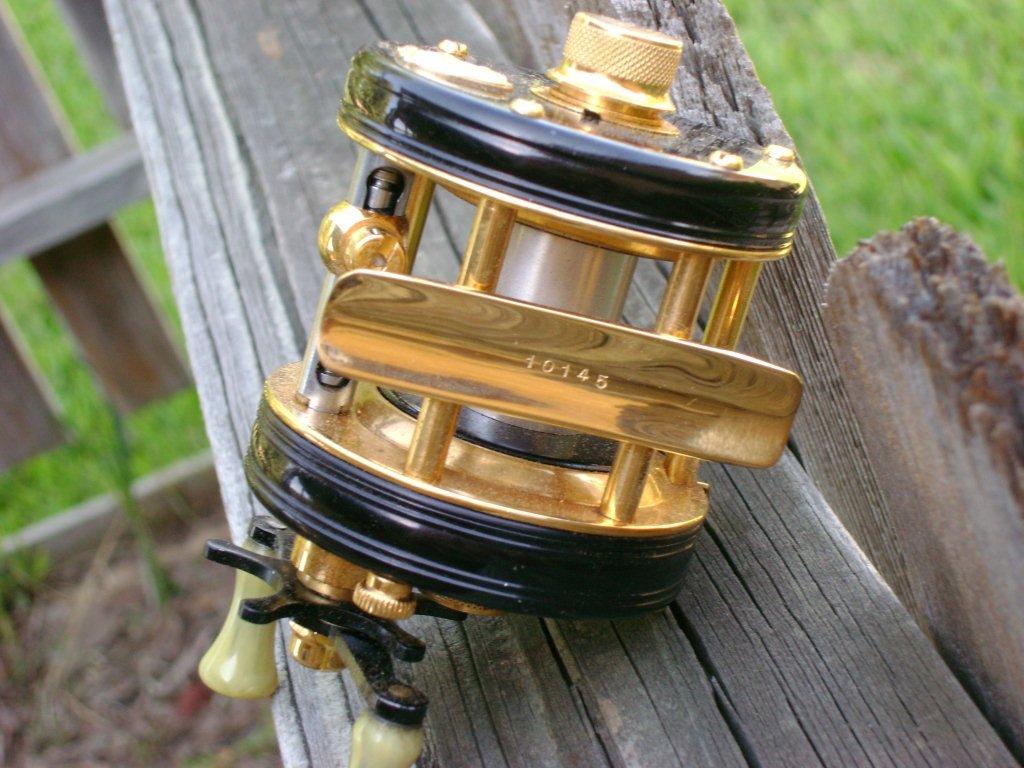
Lowest serial number known at present for 5000CDL - #10145
Currently, #10786 is the highest known serial number for 5000CDL 4-screw version. While the counter-balance handle and gold plated star drag are commonplace, the handle nut with oil port is still in use. Those stamped "oil" once, will soon replace it.
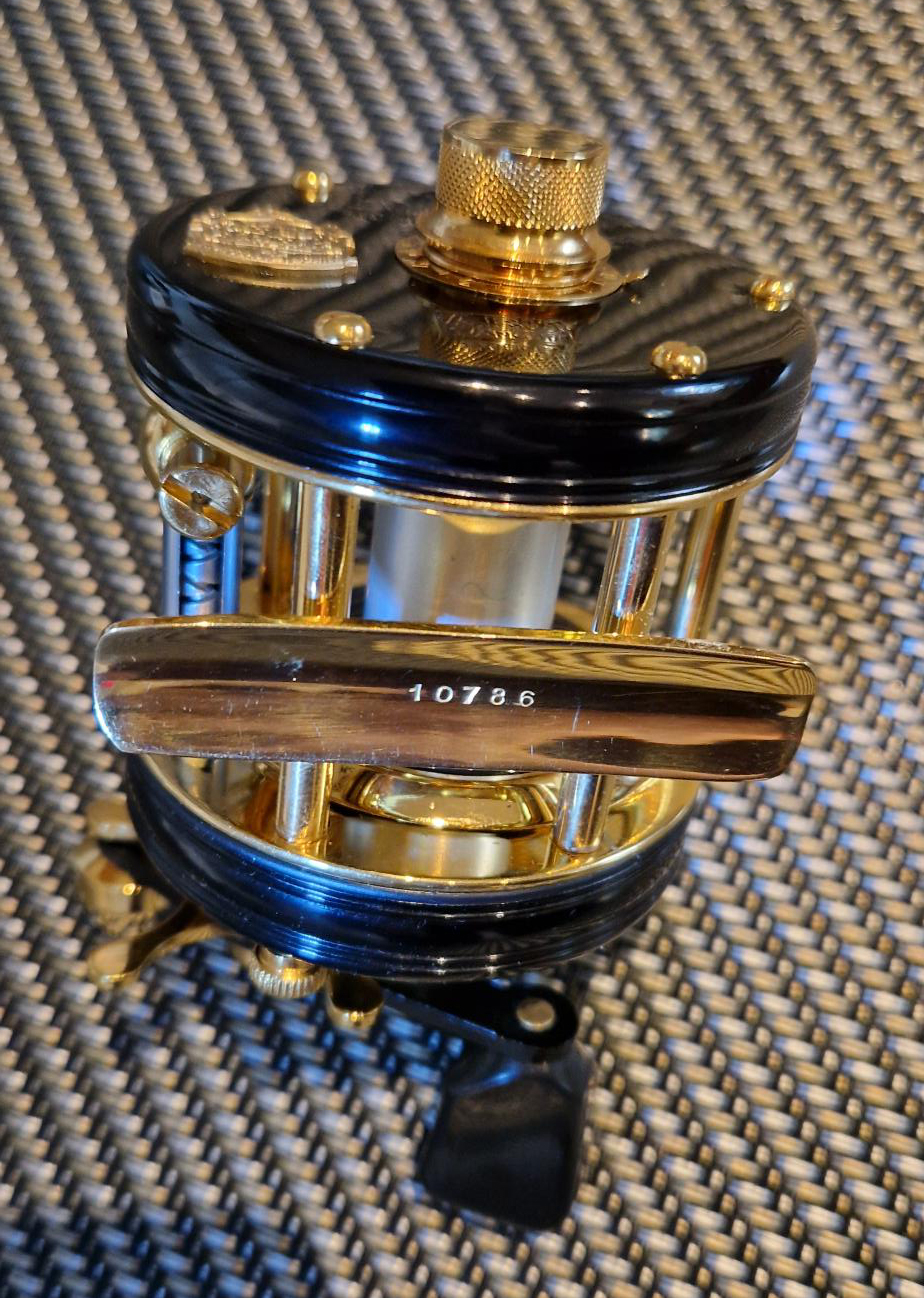
5000C De Luxe #10786....currently highest known S/N as of September 2024
Courtesy: Leif Borglin and Son, Martin Egard
Currently, #010860 is the lowest serial number I've recorded for 3-screw 5000CDL. Complete transition from 4-screw to 3-screw would have taken place somewhere between #10786 and #010860. The lead "0" in #010860 is a dummy number used by ABU and does not affect sequential numbering. The actual serial number is #10860. Dummy numbers are not present on De Luxe reel foot and are limited on C De Luxe reel foot. They are usually found on boxes in the form of an ink stamp, stenciled white sticker or pin holes punched through the cardboard sleeve. I've seen boxes with as many as four zero's preceding a serial number. Don't confuse dummy numbers with the earliest "lot number" arrangement either. 5000 De Luxe and C De Luxe models manufactured in the 1960's and 70's had serial numbers only.
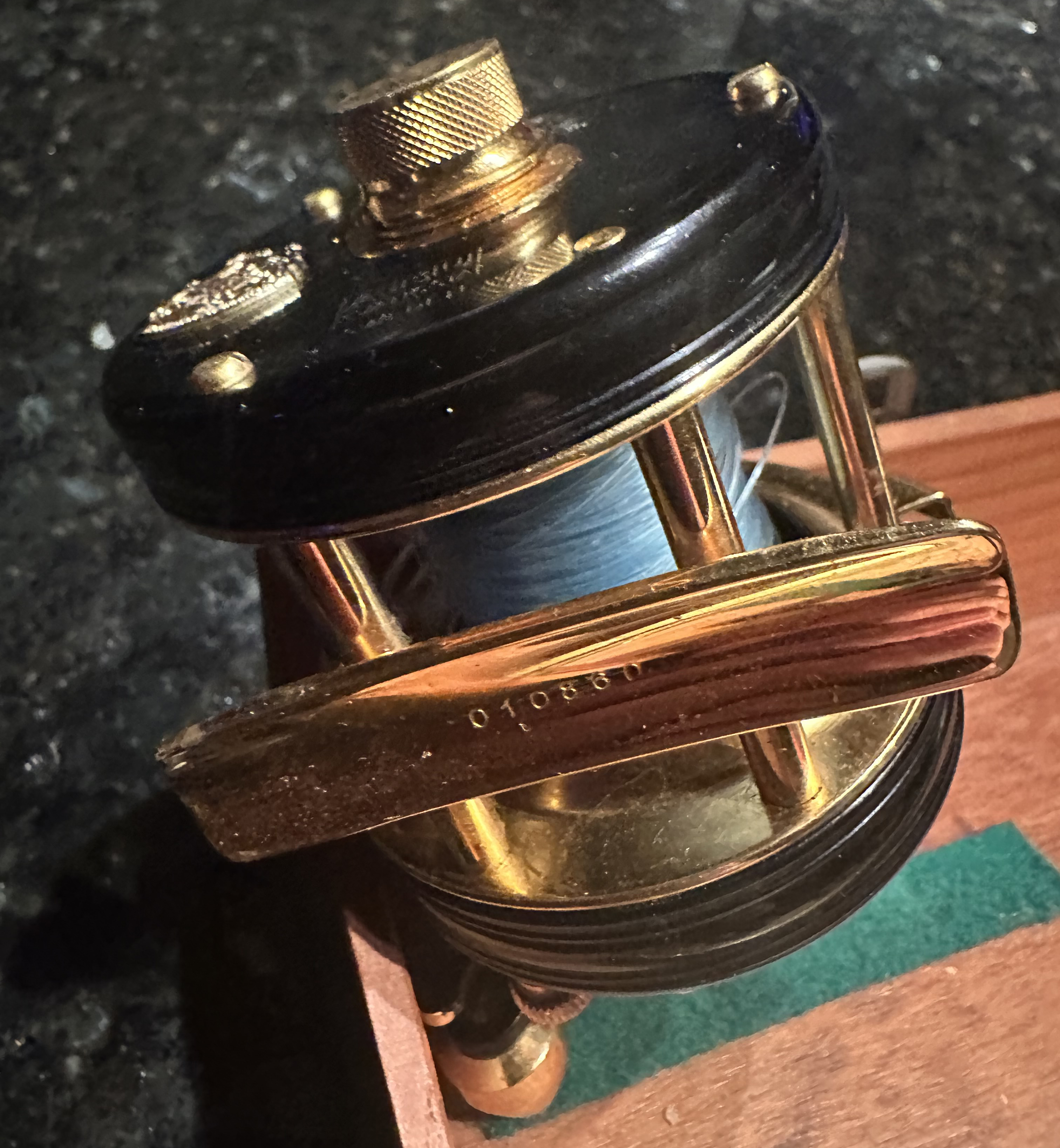
#010860 - Lowest 3-screw serial number known by me as of October 2023
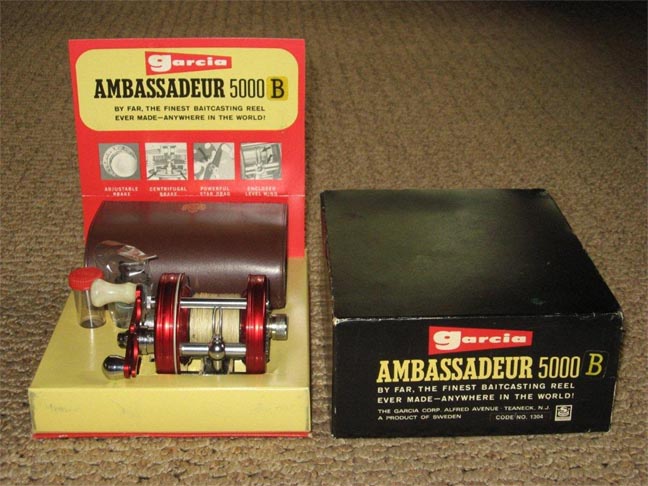
View showing display card and box top with "B" sticker added
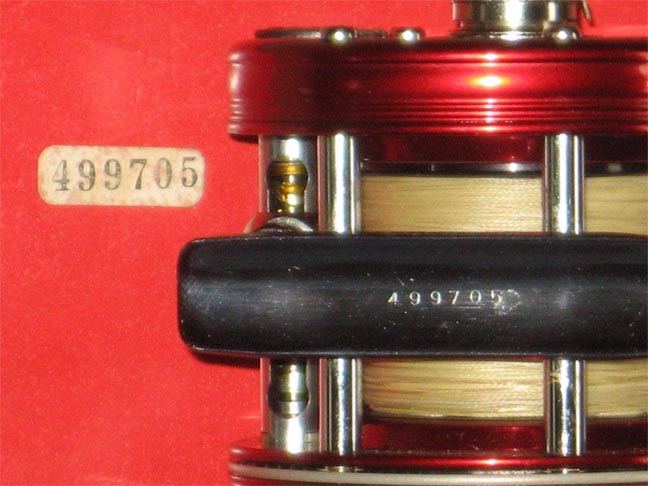
Serial number sticker with matching reel
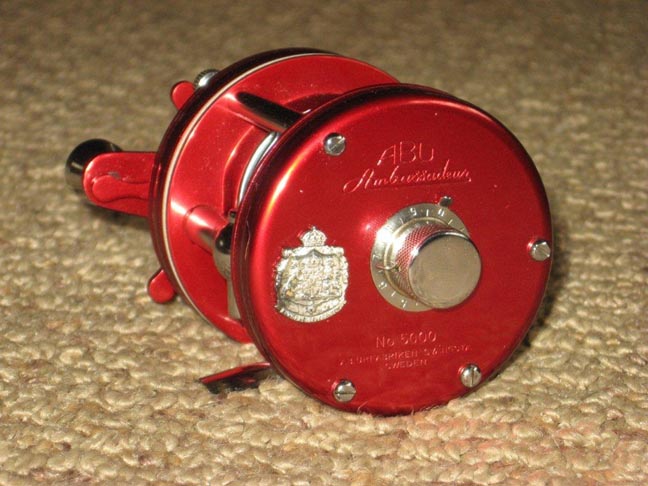
5000C HISTORICAL NOTATIONS
Here are some of my findings for the Ambassadeur 5000C during its life span. Production for this model began in June 1966 and was introduced to the public in 1967. The 5000C had its own set of serial numbers which started at 10001. Although first made in 4-screw version, ABU changed all of their reel frames to a 3-screw version about eighteen months later in early 1968. According to ABU log books, #189010 is the highest serial number entered before lot numbers took over sometime in late 1971.
067100....June 1971. Earliest lot number I've recorded for 5000C. Unless an earlier lot number exists, serial number 189010 may have been manufactured in either June or July 1971 since no date was recorded for it in ABU's log book.
Simon has said, "It's a continual process to find the two sequential serial numbers that define the frame change from 4-screw to 3-screw." My serial number research and supporting 6000C evidence continues to lead me to January 1968 as the date of the frame change. Between Simon and I, we hope to accomplish this through discovery of new serial numbers. If you own a 5000C with serial number between 35064 (4-screw) and 35158 (3-screw) please contact me using the address at the top of this site. Currently, I'm only 94 reels apart.
Researching the 6000C has allowed me to further my studies for the 5000C and the frame change. Below is a photo of one of the very first 6000C's produced in January 1968 with it's supporting schematic reflecting lot number 01 08 00. In my opinion, we now know the date of the frame change from 4-screw to 3-screw occurred for all models in January 1968.
According to Simon Shimomura's writings, most but not all 5000C 4-screw models have the silver colored spool arbor. My research indicates reels with this spool are almost always confined to those with serial numbers beginning with 1xxxx (5 digit.) Virtually all others will have a solid black spool. I once owned #26227 (below) new in the box with the silver spool arbor. The box bottom has the matching serial number to the reel. To date, it's the only one I've confirmed as original with 2xxxx as the starting digit. The box style below is European and does not come with the Garcia wedge shaped banner.
Another aspect of reels made for the European market are the subtle differences one can find versus models made for America. The European 5000C for example can be found with black anodized counter-balance handle and aluminum star drag anodized in black. It's also found with the small twin knob handle anodized in black and chrome plated star drag. Those delivered to Garcia for the American market were always assembled with chrome plated star drag and small twin knob handle. It wasn't until the mid 1970's that the counter-balance handle was used for American market 5000C. This is just one example of the differences found between these two markets. There are others and they affect certain models and their production times.
The stand-up card display box below was used in the 1960's. Variations such as color and shape exist for models found in them. The display card here is interesting because of the sticker placed above "5000" which reads, "Model C with ball bearings." Could this be the first 5000C box used in the U.S.? Box and display cards marked with Garcia wedge shaped banner are for American market only.
Thanks to a gentleman collector from Japan, I received pictures of #188623. This is currently the highest serial number I've personally seen for 5000C. If you own this model with a serial number between 188623 and 189010 (last entry in ABU log book), please contact me so I can record it. As of 2/17/17 I'm 387 units apart from where 5000C serial numbers were discontinued and lot numbers took over.
AMBASSADEUR REEL FOOT NUMBERS
5000 and 6000 models were experiencing transitional changes during the early years. While spool and star drag color arrangements listed below are the ones most often seen with respect to the category they fall under, there may be variations not listed. Other parts such as those found on brake plates are not discussed.
No foot number
The earliest Record 5000 model was engraved MOD SG and is located on the lower left side plate. It was sold in the European market only in 1952 until sometime in 1953. In 1954, RECORD Ambassadeur 5000 (no SG marking) made its debut in the United States. Variations of star drag and spool colors can be found as things were quickly changing in the early years. Earliest examples will have a solid gray spool and star drag. Slightly later models are seen with gray spool arbor/red flanges and solid gray star drag. Still later examples are found with gray spool arbor/red flanges and red star drag. The last arrangement is likely near the time serial numbers were about to be used.
Pictured below, is a rare version of Record Ambassadeur 5000A. Not serialized yet, this example has gray arbor/red flanges and a red anodized star drag.
RECORD Ambassadeur 6000 new in 1955 is mentioned here because this model never received serial numbers. The spool had gray arbor/red flanges with red star drag and never changed. This does not apply to prototype RECORD 6000 as some models were anodized in black having a solid gray spool and small black star drag. It's unclear at this time why ABU continued the practice of no serial numbers until 1964 when the first lot number was applied. Currently, the earliest lot number I've found for model 6000 is #070400 made in July, 1964. Early lot numbers are explained in detail later in this segment.
Serial numbers
The first use of a serial number may have started in late 1955 or early 1956 and was used only on the 5000 model during the 1950's. The need to serialize was so ABU could keep better track of production. According to Simon Shimomura's studies when he visited the ABU factory, the earliest serial number records were either lost or destroyed. ABU may have already manufactured somewhere around 50,000 reels beforehand, as the lowest serial number ever found is #50047. It's widely accepted among historians and collectors that #50000 is likely the first serial number for an Ambassadeur reel. Serialized models are commonly seen with spools having gray arbor/red flanges with red star drag. Serial numbers are for reels mfg 'd. in sequential order and will be either 5 or 6 digit. They can not be used to date reels to a specific month or year unless you have the original shipping record information from the factory. Below is the earliest known serial number for Record Ambassadeur 5000. The spool is gray arbor/red flange with red anodized star drag.
Pictured below is a Record Ambassadeur 5000 with an extremely rare plain brown cardboard box stamped with the matching serial number. This is a complete package with unmarked Record case with chrome buckle. Courtesy of Dan Parker. S/N 63485
Lot numbers
There are three types of lot number arrangements used to identify the month and year a reel was mfg 'd. They were used from mid 1964 into the 1980s. Identical lot numbers can be found on many reels within a given model. If you’re not sure the frame is stamped with a serial number or lot number, try breaking down your reel’s 6 digit number into 3 groups of 2 numbers each. As an example, lets use a known lot number of 73 09 02 or a random serial number of 71 13 09. Using the 3 types of date codes below, see if you can make the first two group of numbers represent a year AND a month. If you can not, it’s definitely a serial number. As far as I’m aware of, revision number “07” is the largest number carried throughout the 1970’s for an Ambassadeur reel and was issued to model 6000.
Earliest Lot Number
The earliest use of a lot number started in 1964, and is read quite differently than the second and third type codes. The 1750, 1750A, Abu 3000, Amb. 4000, 6000(C) 8000 and 9000 can be found with the earliest date code arrangement.
There will be 6 digits on the reel foot. An example might be 080400. Reading the numbers from left to right......The first two numbers of "08" are for the month of (August).....The third digit will always be a "0" indicating the number "6" for the 1960s decade. The fourth digit in this example "4" is the actual year of that decade, 1964. The last two numbers "00" would reflect the number of revisions made to the reel which are none in this example. Another example might be 120501. (12) December (05) 1965 (01) revisions.
How you read a lot number changed in 1970 with the second and third type date code. Now, the actual year "70" was used.
Second type: MMYYXX....month, actual year, revision. 1970~mid to late 72.
FRAME and VERSION NUMBERS
Knowledge of the Ambassadeur reel is key to owning an authentic and original condition collection. The fact that many of their parts are interchangeable makes it even more important you understand when and what reel these parts were assembled to. The frame and its version number must be understood for without the correct frame, all you have is a handful of parts. There are two books on the market by author and historian Simon Shimomura. The first, The Ambassadeur and I and The Ambassadeur and I, Final Chapter are must have books if you really want to understand these reels.
The last two numbers of six total can tell you what frame belongs to a given model. When each new model first came out, the assigned lot number always ended with "00." If there was a mechanical or parts design change, the version number would reflect that change with "01" "02" and so on. Lot number 740500 has no design changes. #760903 had three design changes and is now the fourth version. Frames can not be swapped without you knowing it due to its version number. One exception is the 4500 and 4500C. Produced in 1977, both had "00" as their version number and stayed this way throughout the 1970s. Certain frames can not be swapped simply because of color or width of the frame. The Final Chapter book by Simon Shimomura has a segment that shows all models up to 7000 with the majority of their version numbers.
ORIGINAL/REPRODUCTIONS: Plates, Decals, Handles, etc.
Side plates made for casting models in the 1970's have a distinct design that sets them apart from reproductions made in the 1980's and beyond. As ABU eventually discontinued models, they still manufactured replacement parts years afterward. Recognizing subtle differences in tooling is the key. There are several physical aspects to consider but for simplicity purposes, the cog wheel post and quick take-down thumb nuts are two items the collector should easily be able to identify.
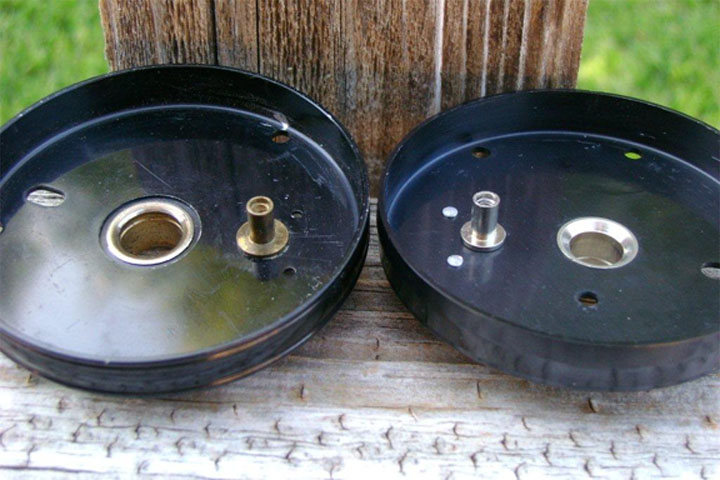
Cog wheel posts in brass (left) and chrome plated (right)
Second pattern used, and most common, is Male knurling seen on this 1978 4500. Male knurling does not have the "XXX" pattern. This design appears similar in shape to that of diamonds set close together.
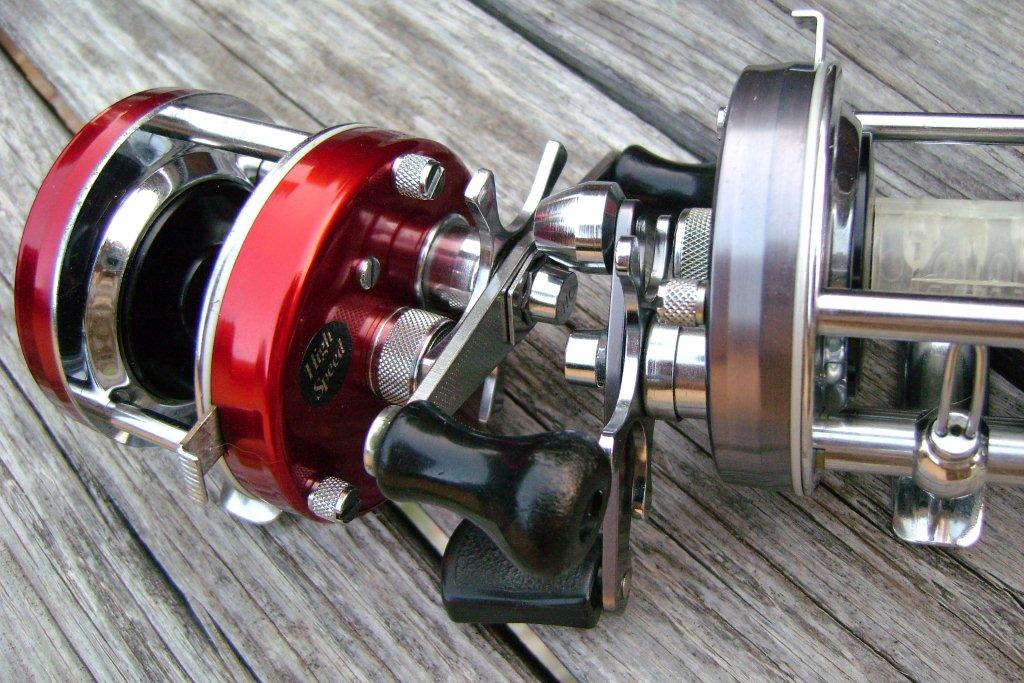
Male knurling (left) and female knurling (right)
Simon Shimomura side plates
Simon Shimomura is author of three books on collectible Ambassadeur reels and is considered an expert and historian of Ambassadeur. He manufactures his own line of custom-made "Classic Ambassadeur" under a license given to him by Pure Fishing (ABU-Garcia). The quality of his reels meets or exceeds the same quality standards set by ABU in the 1970's. Original ABU stamping dies from this period are used for most of his production making his side plates almost identical to ABU. In some cases, colors match ABU's as well. Fortunately for collectors they can still be identified upon close inspection.
Looking at the numbered dial around the bearing housing, the "7" font on the right is correct for ABU original and reproductions and has never changed. The left plate is Simon Shimomura's. Note the tear drop or hook on the leading edge of his "7." Simon anodizes his plates in colors known to match those manufactured by ABU and champagne gold is one of them. Look for Simon's unique 7 font on all his plates.
Update - FEB. 2018
It has been brought to my attention that some collectors have side plate concerns after reading the paragraph above. In question is the left plate's numbered bearing housing with "hook" or "tear-drop" shape font on the leading edge of the number "7". There are variables to consider such as production model, limited models and year(s) made with and without "7" hook font. The following information was given to me by Simon Shimomura but should not be considered as all-inclusive.
Pre-1980 ABU production items do not have "7" hook font. In late 1980's, 2500C IAR, 2600C IAR and possibly other models, are known to have both "7" font versions. Around mid-1990's and beyond, ABU production used both "7" font versions. Simon Shimomura side plate manufactured before 2015 have "7" hook font. Simon's plate manufactured 'during' 2015 ~ 2017 do not have "7" hook font. 2015 is a transitional year so the "7" hook font can be found on some of his items.
My web page is dedicated to classic-era Ambassadeur only. The information in this section is meant to bring attention to part detail for classic-era models only and the collectible affect it may have on them.
Anodized finish inside Simon's plates are 100%. This is not necessarily the case with all ABU original or reproduction plates. One will usually find at least a small spot or two (if not a sizeable area) where anodizing appears to be rubbed off or incomplete. This is caused by buffing compound residue left undetected during the cleaning process just prior to anodizing. The residue particles form a barrier between metal and dye causing incomplete anodization.
Model stickers are another concern. Notice how the letters are jammed together and the "4" in 4500 is open at the top. This is a classic example of a reproduction sticker and is not original for reels made in the 1970s. Original stickers will have clear, sharp and defined spacing between each letter and the "4" will be closed at the top like the one I typed. Reproduction stickers are easily obtained on eBAY®.
Reproduction handles are easily overlooked unless you know what to look for. Many handle styles used during the classic years which ended in 1979, were reproduced in later years. In the example below, the handle in the foreground is original for reels made in the 1970s. Notice the post pin is slightly dome shaped while the post pin on the reproduction handle in the background is noticeably flat and is level with the paddle. The reproduction also has a different texture on the paddle. It is much finer in texture compared to the green handle which is original. All reproduction handles will have a flat post pin.
This is the brown version of the 6500 bushing model, or so one might think? The earliest production for this model was 1976 with introduction to the public the following year. Smooth foot for all ABU models ended in late 1972 with the new and improved foot with dimples around its lot number. The frame used here is for a common 6000C with an early lot number of 080800 which was made in August 1968. The handle arm with mesh design was never offered on the brown 6500 and should be mirror finish only. Correct star drag will have straight cut ends only, as this one is tear drop shaped. Take a close look at the brake plates color and you'll see it's black. Brake plates for original brown 6500 are silver. There is little doubt that all mechanical parts inside this reel are those from a 1968 6000C. End result, you just bought two used side plates!
The 5500CDL below is a forgery. Note the poor attempt at gold plating a common 5500C frame with lot number 760903. Gold plating is missing in several areas you shouldn't see during normal use or handling. An authentic 5500CDL always carried a version number of "00" and nothing else. This means they never received a design change during their short production life span. There were only 500 made and released in two batches. First batch: #751100. Second batch: #760900 #761000. This example sold online for a large sum so be careful when considering highly sought after models.
LETTER/NUMBER DESIGNATIONS
Record Ambassadeur 5000 MOD SG was the first Ambassadeur bait cast reel made. Marketed in Europe in 1952-53, it was not sold in the United States. Sometime in 1953, the "MOD SG" mark was removed from the lower left side plate which leads us to the American version.
5000.....Introduced to the American market in 1954, Record Ambassadeur 5000 came equipped with a standard capacity spool. This reel never received an engraved letter designation.
5000A.....Record Ambassadeur 5000A is added to the line up in 1955 along with the debut of Record Ambassadeur 6000 and is the first known "A" model. According to Simon Shimomura's studies, it became apparent that a large capacity spool was needed. Although never engraved with "A", 5000A is listed for the first time in Garcia's 1957 catalog. In fact, the 1957 trade catalog is Garcia's official introduction to the public for the Ambassadeur 5000, 5000A and 6000 model. It would be twenty years later in 1975, when "A" was engraved beside the model number.
A transition was taking place between 1956-58 as an unknown number of 5000 models had neither "Record" or "ABU" engraved above "Ambassadeur" on the left side plate. Soon after the beginning of 1958, "ABU" is now engraved above "Ambassadeur" on all 5000 models. Production for "Record" engraved 5000 ceased by the end of 1957.
5000B.....Introduced in 1964, this reel is commonly known to collectors as the 5000 with a clicker. Actually when first produced, it didn't have a clicker but was sold with a counter balanced handle and large capacity spool. The box was marked "5000B" with matching serial number on the box bottom. About two years later a clicker was added. The reel itself was not engraved "B" until 1975.
5000C.....Introduced in 1967, this was the first model mass produced with "C" engraved beside the model number. "C" denotes the use of ball bearings; however, the 5000C was not the very first model to use them. The 5000De Luxe introduced in 1962, was the first. Since mass production of a ball bearing model started in 1966, it made good marketing sense to engrave all future models that used ball bearings with the letter "C."
5000D.....Introduced in 1974, the "D" designation stands for direct drive. Although earlier direct drive models were produced by ABU, the 5000D was quite different. It incorporated an adjustable drag system with the free spool concept. During line retrieval the reel is in direct drive. Taking your hand off the paddle allows the drag system to take over as the handle rotated backwards. Adjustment of the knurled aluminum knob sets the desired tension of drag washer pressure.
Models listed above with exception to ball bearing models, used bronze bushings. The complete list of bronze bushing models are listed here: 4000D, 4500, 5000(A,B,D) 5500(D) 6000, 6500 and 7000.
NUMBER DESIGNATIONS
As anglers wanted faster retrieving reels, ABU responded by introducing models with high speed gears. The original gear ratio was 3.6:1. ABU's first high speed model was the Ambassadeur 5500C introduced in 1973 with a gear ratio of 4.7:1. The high speed designation is in the second digit such as 5500C. In the late 1970s, ABU introduced its high speed model with the Thumbar. Designation for Thumbar is also in the second digit such as 6600C. 4600C, 5600C and 6600C were ABU's only Thumbar models produced during the classic years which ended in 1979. From the time ABU's new Thumbar technology came into the market, it revolutionized the sport fishing reel. Virtually all bait casting reels today use similar technology.
High speed models include: 1500C, 2500C, 4500(C) 4600C, 5500(C,D) 5600C, 6500(C) and 6600C. Information in this segment does not apply to model numbers higher than 6600C.
PARTS AND YEARS OFFERED
As I've mentioned before, the collector should pay attention to part design changes since many of them are interchangeable with different models. Some of the design changes are, but not limited to, handles, handle nuts, side plates, take down knobs, star drag wheels, spool tension caps and others. It may sound overwhelming to figure all this out, but it can be determined with a little initiative. Simon Shimomura's books are an excellent guide to help answer these questions and one would be wise to purchase his books.
1972 is a great example of a year that saw major design change and is the easiest way for me to explain "bleed over" or "overlap" of parts that are original to any particular model. The collector will find some reels that didn't reflect that change immediately.
In 1972, beveled rim side plates with screwdriver type take down knobs were new yet you also find groove rim with newer take down knobs too. Why is this? The answer is simple: It's the over lap of old style parts being used on next season's reels. ABU would not simply throw away old stock parts. They were assembled to the latest models until exhausted. Design changes for other parts such as spool caps, handles, handle nuts, etc. can experience the same thing.
It should be noted that these differences most likely will not extend past one year. In other words, you shouldn't normally find a reel made in late 1973 with grooved rim side plates. Garcia's fishing season begins in July and ends in June the following year. This can be noted by opening the cover page of a Garcia Fishing Annual. The date is located at the bottom right hand corner of the first page and it will precede the year found on the magazines spine. A reel purchased sometime during the Summer of 1972 could have old stock parts from 1971 assembled to it.
Here are two examples of the differences you may encounter with over lapping parts. This 5001C has correct beveled rim plates, but has mushroom style take down knobs which are more commonly seen on grooved rims. Lot #097200 September/1972.
This AMB. 6000 has grooved rim side plates with newer style take down knobs which is more common to beveled rims. Note the early March date of this reel which is well within the year limit. Lot #730303. 1973/March.
SPECIFIC PART MODIFICATIONS
Part or design modifications were not necessarily confined to broader measures like side plate styles or reel foot designs but rather some of the changes were more specific in nature. The Ambassadeur 2000 was introduced in 1962 while its narrow spool cousin 2050 made its debut in 1964. The first series of Ambassadeur 2000 is easily recognized by its carriage screw nut found on the left side plate. With the introduction of Ambassadeur 2050 in 1964, parts for the first series 2000 such as the carriage screw and others were redesigned to mirror those found in the 2050.
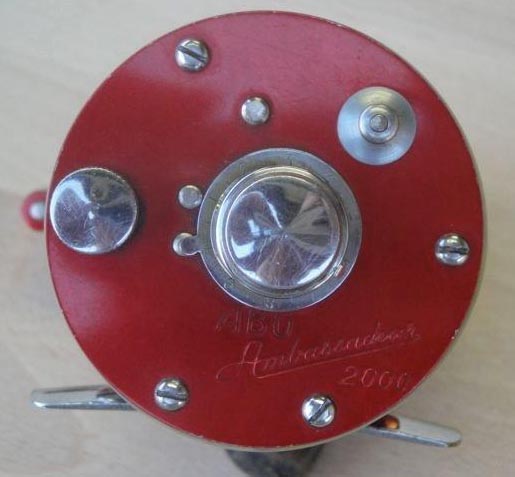
"ABU" engraving is located underneath the spool cap. This may be the earliest 1st. series 2000 model made. The foot is stamped "Record" in the fish shaped logo with "Made in Sweden" below it.
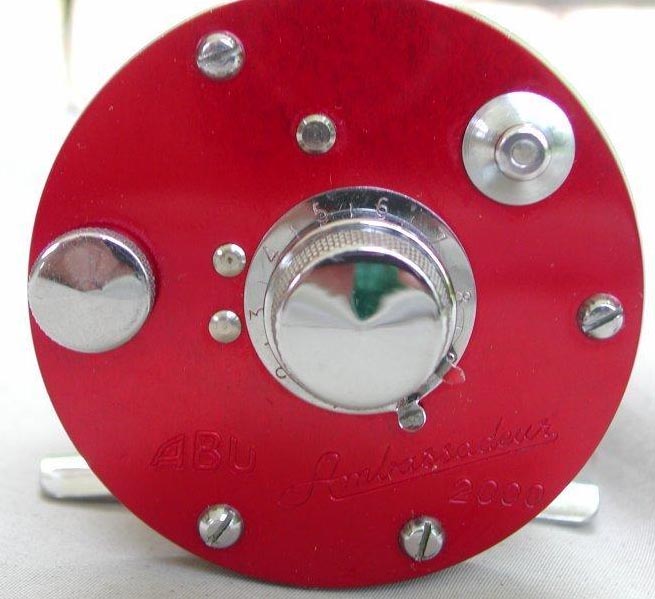
Common 1st series side plate showing carriage screw nut part #2234. "ABU" engraving is located well to the left of spool cap.
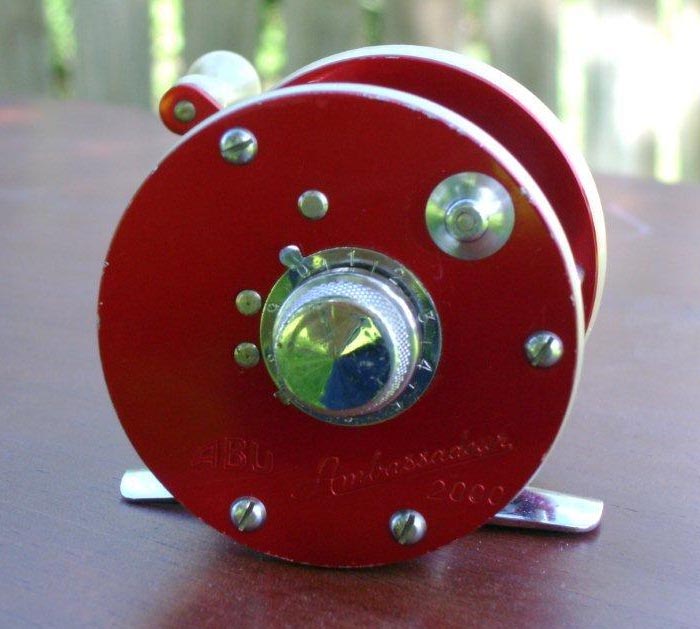
2nd series side plate. Carriage screw nut part #2234 has been discontinued. "ABU" engraving is well left of the spool cap.
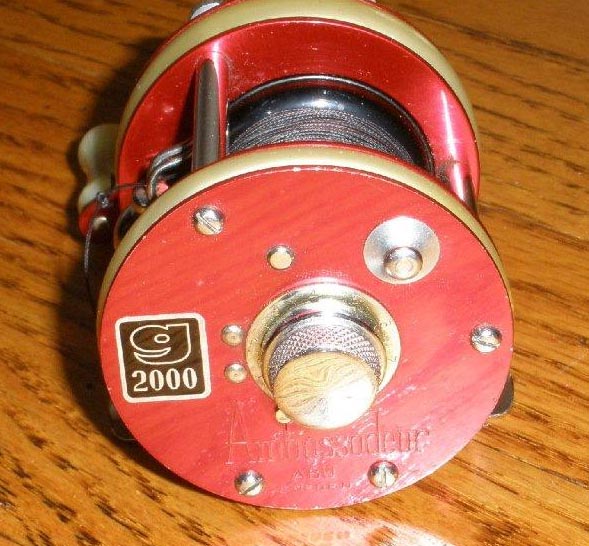
G2000 decal replaces "Ambassadeur 2000" cursive engraving. This change was another way to curtail cost and was more than likely introduced near the end of production. Left side plate part #2293 fit models (2000 2nd series), 2050, 2500, 2600 and 2650.
Another example of specific change was the 5000D. With introduction of the high speed 5500D model in 1978, it was delivered with a model sticker in lieu of engraving. Unlike it's 5000D cousin, the 5500D never had a clicker installed. ABU saw this as an opportunity to cut cost by using the same left side plate for both models. 5000D production in very late 1977~1979 are found without the clicker and a sticker that read "Ambassadeur 5000D." There are other examples of specific change within certain model groups but this should give the collector an idea of ABU's versatility when it came to part usage.
LEATHER CASE INFORMATION
Ambassadeur reels came in various marked cases through the years but the very first case offered had no markings at all. Each case came with correct paperwork for the reel packaged, a spare parts tube, oil bottle and wrench. Case measurements for the 5000 model are 4 7/8" inch long and 6000 case measures 5 1/2" inch long. All cases below appear in chronological order and their dates should be considered very close for the time period offered.
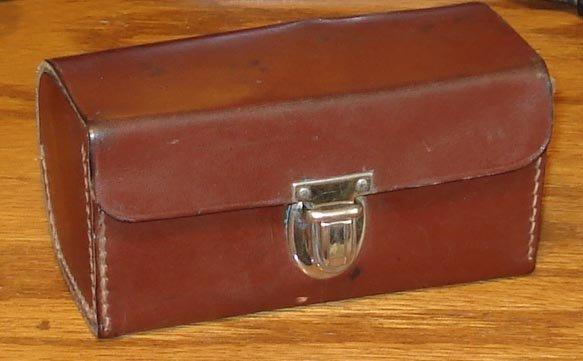
ca. 1952~57 Chrome latch, no script or crest. Record Amb. 5000 MOD SG, Record Amb. very early ABU and non-ABU 5000
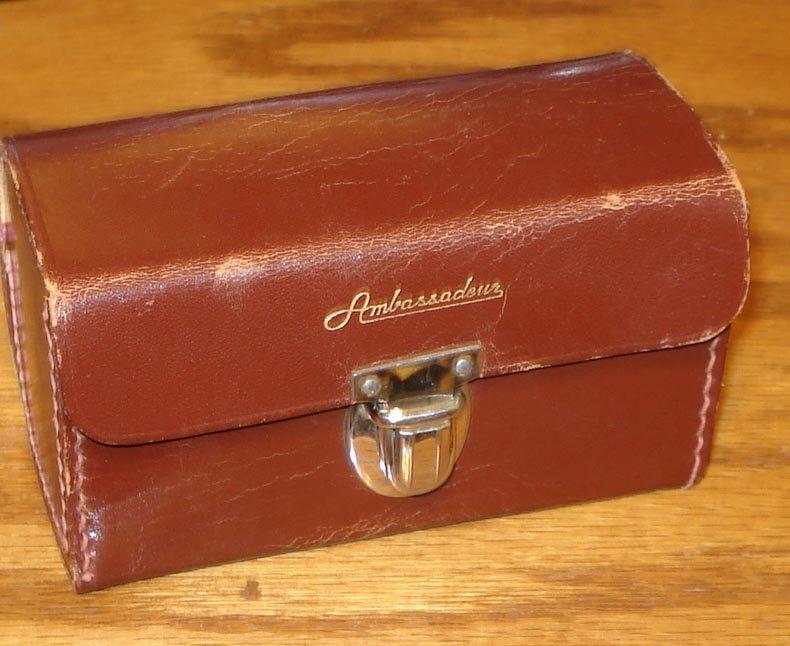
ca. mid to late 1950's, Chrome latch, "Ambassadeur" in script, no crest, Record, non-ABU and early ABU
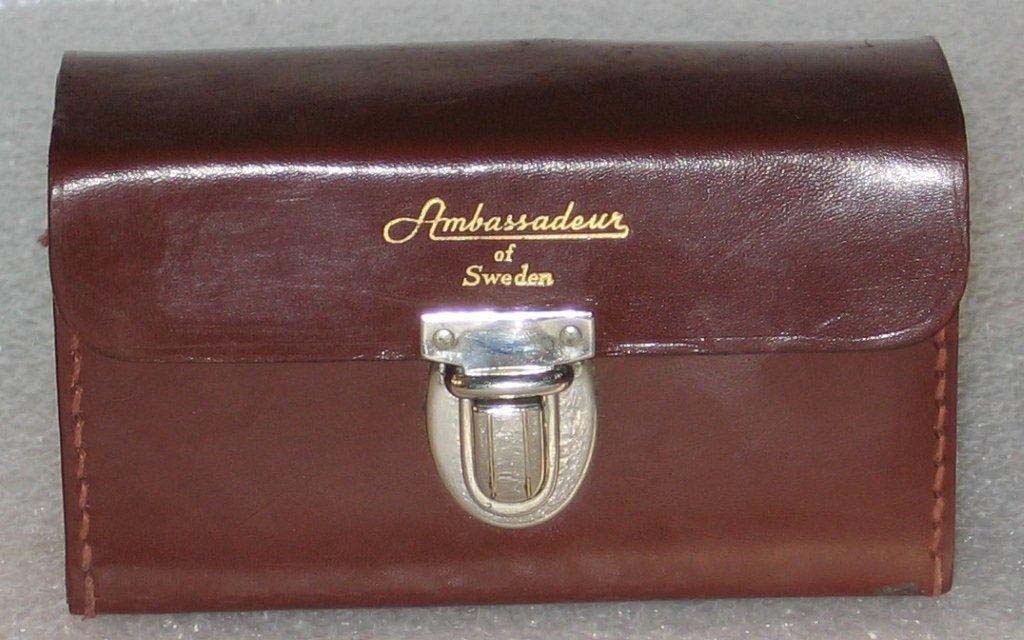
ca. 1958? Chrome latch "Ambassadeur OF Sweden" in script, no crest, (very rare)
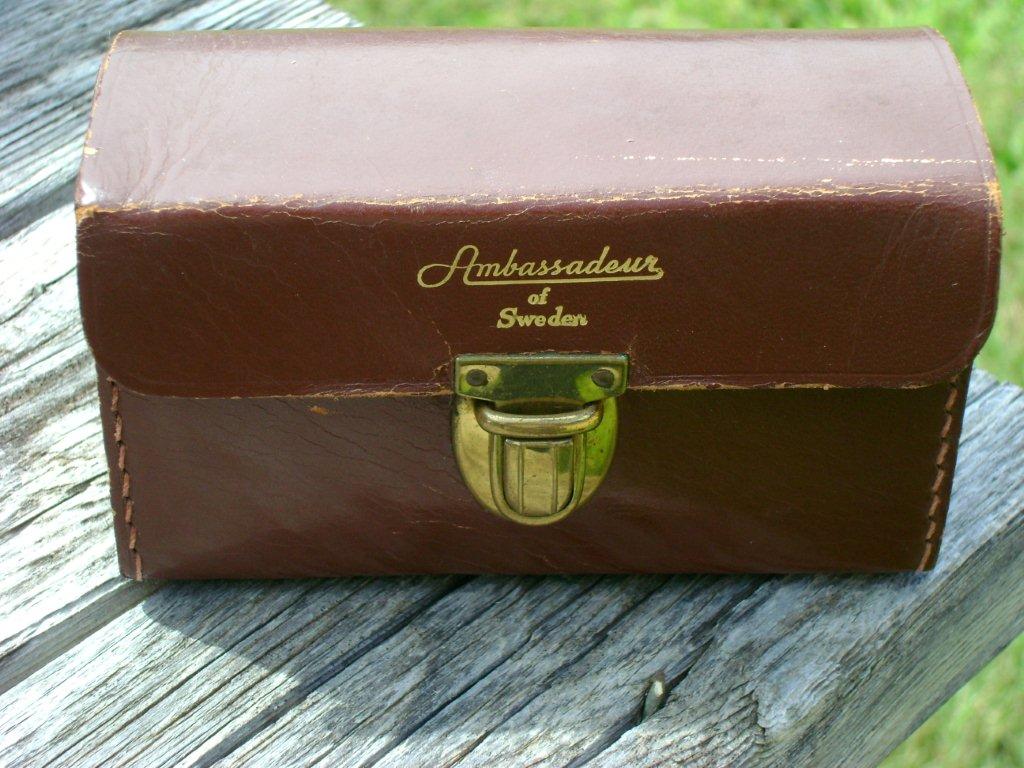
ca. 1959? Brass latch, "Ambassadeur OF Sweden" in script, no crest (rare)
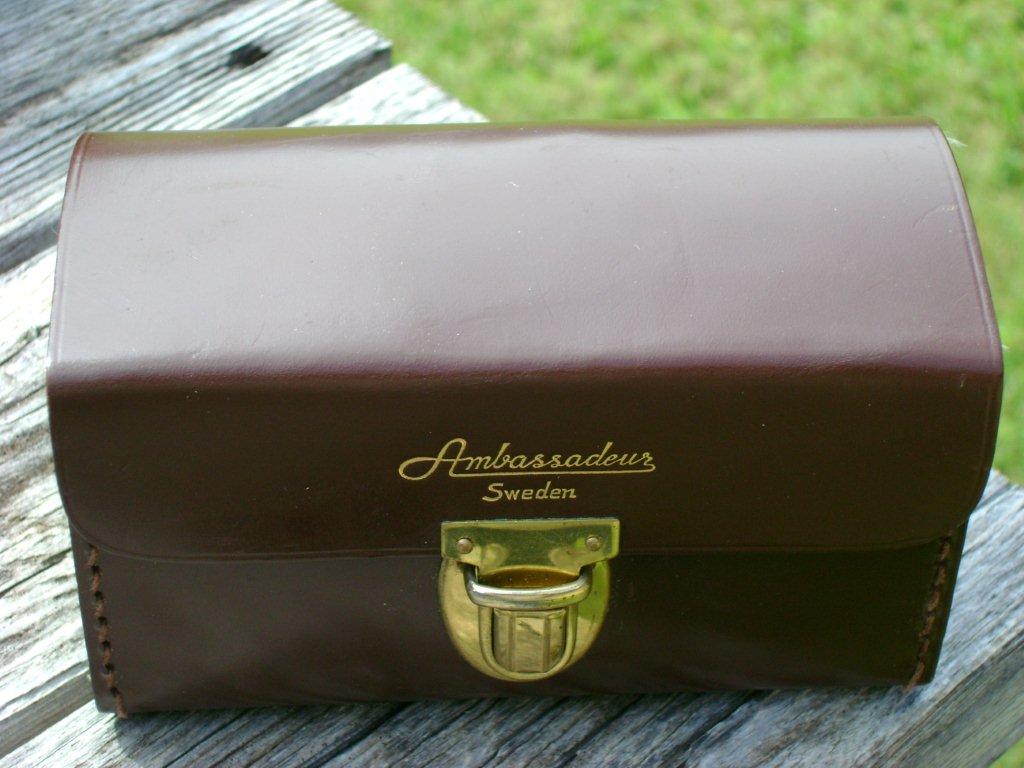
ca. Very early 1960's. Brass latch "Ambassadeur Sweden" in script, no crest
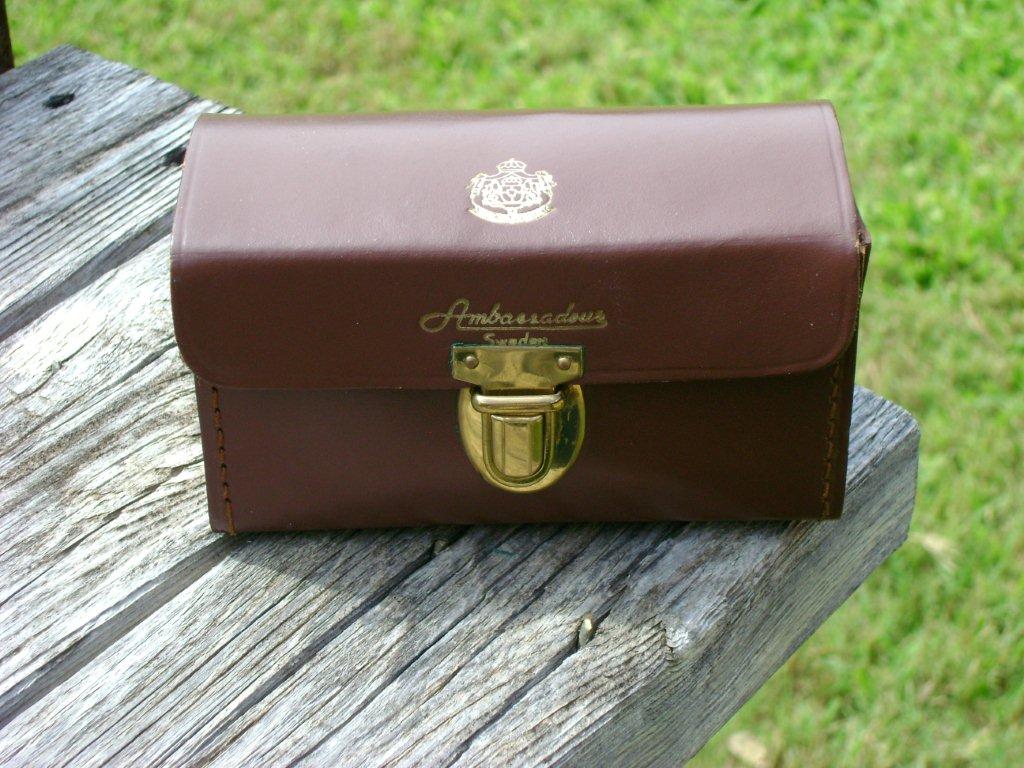
ca. 1960~71 Brass latch, "Ambassadeur Sweden" in script with crest (most common)
BLACK SYNTHETIC LEATHER CASES
The black synthetic leather cases came in three styles. The brown 5500 manufactured in late 1975 and early 1976 was packaged in the last case shown. It should be noted that the correct 5500 handle for this case is the 80mm power handle with twin flat knobs. The 90mm chrome handles that were assembled to the brown 5500 in mid-1976 and on, would not fit inside any case. Some of the information provided here was from my dear friend Simon Shimomura.
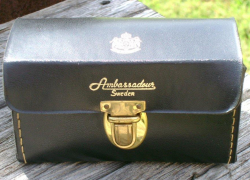
Ca. Late 1960’s “Ambassadeur Sweden” in script with crest
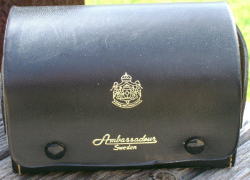
Ca.Early to mid 1970’s, button snap “Ambassadeur Sweden” in script with crest
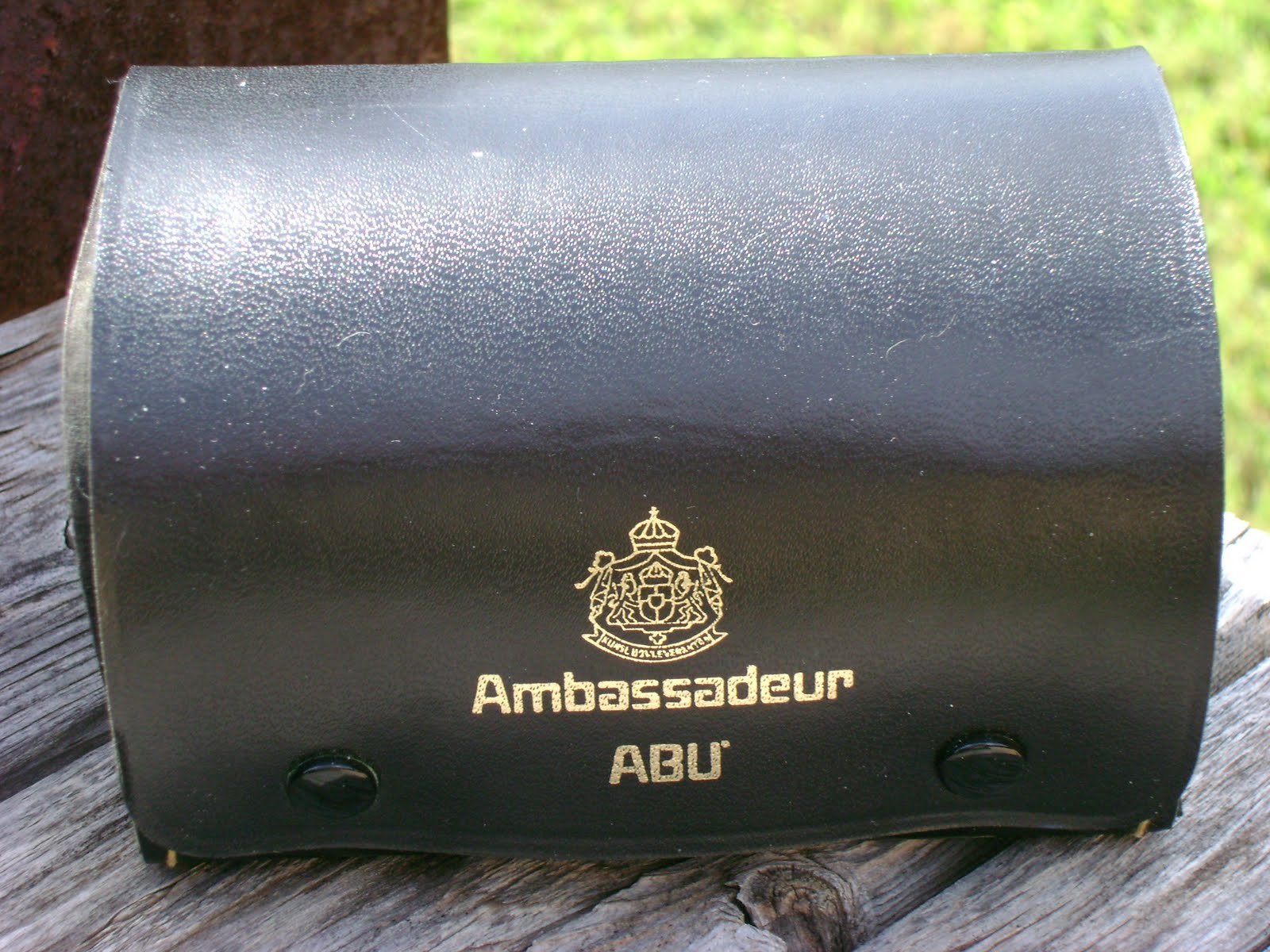
ca. 1974~75 Button snap "Ambassadeur ABU" in block letter with crest. Used in 1976 for certain models.
CLEANING AND MAINTENANCE
I would like to share some cleaning tips with you that I've learned through trial and error over the years. The information given hear has been practiced on every reel in my collection and includes the expensive presentation models which are plated in 24KT gold. Please pay special attention to my explanations of where, and where not to use Acetone. This is a harsh stripper but used carefully, it can do wonders for a reels appearance. These tips are for Ambassadeur reels made from 1952~1979. The composition make up of plastic parts in reels made in 1980 or later may be different. I suggest you spot test first before using this product. Rubber O-rings found on the left bearing housing should not be cleaned with Acetone either.
You will see the various tools I use and are not necessarily the only tools you need. You may find other tools more suitable to your liking, but these should give you a general idea. The four brushes in the middle are rifle bore brushes of different calibers. They come in handy for cleaning the inside diameters of various parts such as line guides, bearing housings, and the right hand sideplate where the drive shaft comes through. Q-tips are the basic cleaning tool. You'll need a large box of these and I recommend the 375 count size.
If you have a reel that's excessively dirty, you'll want to use one of your plastic bristle tooth brushes with dish soap and warm water to clean the thick grease and dirt from your parts. Once done, you can pour Acetone in a coffee cup and soak these parts. All metal parts can be cleaned easily using the Q-tip. Please use Acetone in a well ventilated area. I've shown a picture of the plastic parts you'll find in your classic reel (1952-1979) that can safely be cleaned in Acetone. The composition make-up of these plastic parts will not break down in Acetone. I don't know if the composition make-up of plastic in later reel models were changed up, so I strongly recommend you test it before cleaning. I can only verify my experience with this product for reels in their "original condition" mfg. up to 1979.
HANDLES
Do not use Acetone on any Ambassadeur handle knob or paddle! Acetone will melt it. When cleaning the handle, make it your very last piece to clean. Wash your hands to make sure the Acetone is removed and then clean your handle. Black handle paddles can be brought back to full luster by using Armor-All. First, clean all dirt and grease from them. Using an eye dropper, apply Armor-All onto the paddle and rub it in with a Q-tip. Once dry, repeat this process two more times. If the paddle is excessively dry you made need to apply more but once it holds its original black color you shouldn't ever have to do this again. For round handle knobs, a mild abrasive wax should do.
SIDE PLATES and FRAME
Acetone can safely be used on your side plates with one small exception. Reel models that have stickers showing their model numbers such as the 1500C, 4500, 4500C etc.....can be damaged by Acetone. You will always use a Q-tip cleaning your parts, so use caution around the edges of your stickers. Dip the Q-tip and then squeeze the excess Acetone from it to keep it from running onto the sticker. As an added precaution, tilt the side plate in a fashion to where the Acetone will always run away from the sticker. Frames are easily cleaned with Acetone and Q-tips just like all other parts. Acetone will not hurt the colored dye finish on these reels. Pull small pieces of cotton off the Q-tip and using tweezers, dip it in Acetone and clean those very small and tight areas. Hard films will wash right off and chrome frames will look new again. Acetone evaporates quickly and removes all fingerprints to give your reel the mirror finish it had when it left the assembly line. Of course, this is for reels that have no rash or scratches.
ABU 3000 and AMBASSADEUR 4000
These reels had plastic side plates and were made in mind for saltwater fisherman. Rust was a problem so Abu developed these low budget reels for that purpose. Direct sunlight proved to be the downfall for these side plates as bleaching or fading of colors became a problem. Simply follow my directions above for metal parts and stickers, but DO NOT use Acetone on these side plates. Use plenty of Armor-All and Q-tips to rub it in thoroughly. Watch the color instantly come back to life! Let dry and repeat once. I have found that the side plates will retain their color for well over a year without re-applying. It will not leave a stain. If you live in a very low humidity environment such as Arizona, you may have to apply this product sooner. Living on the coast of Texas for most of my life, we had high humidity and this application worked for around two years or so before re-applying. Below, is an Ambassadeur 2500C before and after cleaning.
DESIRABLE REELS
The fact that I'm predominately a field collector means I don't have most of the rarest reels but here are a few of my favorites.
Early non-ABU marked 5000
The non-ABU 5000 is quite scarce. An unknown number of them were manufactured sometime between 1956 and very early 1958. During this time, neither "Record" or "ABU" was engraved on the left side plate. Serial numbers are five digit and range from 6xxxx to 7xxxx. Fewer than a hand full are known to exist in the low #80xxx range with #80512 being the highest number known by me at this time. So far, all that have been found are assembled with a standard capacity spool. In my opinion they are not unlike the Record 5000 as most, if not all parts used to assemble them, were the same parts used for the "Record" engraved model. Many of them also have Roman Numeral marks etched into the brake plate's bridge, inside both side plates and the frame. The non-ABU 5000 came packaged in a plain cardboard box with leather case like the Record models. To find a complete package with the reel's matching serial on the box as this one does is exceedingly rare and would indeed command a high value. The last picture shows Roman Numeral mark XIII. #68562
5000A
This is an example of a 5000A with gray arbor/black flange spool. There is no mention of this color arrangement for a spool in any of my reading materials. The typical spool assembled to this reel would be gray arbor/red flange. Many of the parts inside this example are for Record models. Record parts were exhausted as ABU used them to assemble "ABU" marked reels as Record Ambassadeur was phased out by the end of 1957. This reel is engraved "ABU" and was mfg 'd. in May of 1958 with the help of a known shipping record. S/N 96601.
The gray arbor/black flanged spool pictured below seems to be connected with 5000 models having a serial number right around the 100000 mark. S/N 96601 (above) has it and I have recorded several other 5000s up to S/N 107927 with this spool. The overwhelming majority I've recorded have been between 103xxx~107xxx. Both grooved, and arbors without a groove have been seen. If your 5000 has a spool with this color arrangement, please contact me so I can record it.
5600 CDL
The 5600CDL is one of the harder presentation models to find. It has been noted by collectors as being more scarce than the coveted 5000 De Luxe which was introduced as the first presentation model in 1962. It was not listed in the Garcia catalog until 1981 as mentioned in Simon's first book. It can be found with subtle differences in parts such as straight cut star drag and bullet shaped counter weight. This example has a tear drop shaped star drag and later style counter weight. First year of production is 1977. Lot #770800
5000 De Luxe
This is the first presentation model Abu made and was introduced in 1962. It's also the only model that used ball bearings and was never engraved with "C" beside its model number. This changed sometime around 1969 as the earliest 5000C De Luxe models were being made. There were many changes made to this model over the years but those made from 1962~1969 have the black anodized star drag and are considered more desirable among collectors.
Parts are plated in 24kt gold and Teak wood boxes were standard throughout the 1970s. Accessories include high capacity extra spool, tube with gold parts, cloth bag with gold draw strings, oil bottle, wrench, sterling silver name plate, and paperwork. 5000 De Luxe started with serial number one (1). S/N 8097
I've mentioned that the frame change from 4-screw to 3-screw occurred for all models in January 1968. One exception to this rule would be that 5000 De Luxe and 5000C De Luxe did not reflect this change right away. One likely reason is that ABU wanted to maintain the harmony of their first gold presentation model. Secondly, ABU would not throw away 24kt gold 4-screw frames. With the new 5000C De Luxe being assembled as early as 1969, it made good sense to use old stock gold parts until exhausted. More about these two reels can be found in my discovery of the 4-screw 5000C De Luxe near the top of this page.
5001C
It seems there's a bit of controversy over the true first version of the 5001C. This was ABU's only left-handed model made during the classic years of 1952~1979. 5001C production was 1971 and introduction to the market was 1972. The first version had grooved rim side plates with mushroom style takedown screws. Virtually all known have beveled rims and either mushroom or screwdriver style takedown screws. The confusion seems to be if you have a 5001C with mushroom style takedown screws, it must be the first version. This is not accurate as there are other features that have to be met before you have a true first version. The reel must have a smooth foot, smooth top spool tension caps (left side skirted) small twin handle AND grooved rims. Having met this criteria, it would be considered one of the toughest reels to ever obtain. In all my years of collecting I've yet to come across this version, however, I have seen this model with all the features I mentioned but it had beveled rim.
Pictured is my 5001C with mushroom style take down knobs. This reel has beveled rim side plates and mesh top spool caps. The reel foot has dimples around it's lot number. Still a very desirable reel, it's not the true first version. This reel was made in September 1972 with lot number 097200. The fact that the last two digits in the lot number are "00" which indicates first version are a mystery to me. Normally a parts design change would have prompted the version number to change but this didn't happen until January of 1973. It may have been due to the very low numbers of 5001C produced with smooth foot and grooved rims. 1972 saw major changes with the introduction of beveled rims and dimpled reel foot. 5001C was produced into the 1980s.
5000C 4-screw
Produced in 1966 and introduced in 1967, this ball bearing model would be the first reel engraved with "C" beside its model number. This was not the first model to use bearings, as that claim belongs to the presentation 5000De Luxe model in 1962. For approximately the first eighteen months of production, the 5000C was delivered in a 4-screw frame until January 1968 when all ABU frames changed to a 3-screw version. 5000C was produced into the early 1980s with straight cut side plates before palming cup took over. Refer to 5000C Historical Notations for more information on this model. S/N 26227
ABU Ambassadeur 2500
Production was 1961 and introduction was 1962. It was only available for the 1962 season and dropped from the line after that making it one of the hardest reels to collect. The 2500 was a direct drive model along with the 2000 and 2050. The 1750, 1750A, 2600 and 2650 were the free spool models of seven total for this series of reels. Engraved with it's model number, it was not serialized but stamped "Made in Sweden" on the foot. It came in a beautiful stand-up display box similar to those for the 5000.
The large knurled aluminum knob is part of the drag system which was incorporated into the handle. By tightening the knob to a desired tension, you could apply drag washer pressure against the drive gear assembly which is similar to the conventional star drag wheel. Holding the handle still you will notice the knurled knob rotating when the fish made his run. Finding one new in the box would indeed command a high value.
Brown 5500
The 5500 is found in light and dark variations. Some appear in a copper/bronze finish while others appear to have a maroon tint. This one is chocolate in color. Lot number 751100 is the earliest production date found for this model. In February 1976, version number "01" was added and remained this way throughout its production life ending in early 1977. This example comes complete in the thin cardboard style box with end flaps. Finding an Ambassadeur with the original price tag still attached is not often seen. Lot number #760201
5000C
With production starting in mid 1966, the 5000C was made into the early 1980's with straight cut side plates before palming cup took over. It was one of the last models that retained the beauty of ABU's classic era. This example may be one of the very last one's mfg 'd in this style as its lot number indicates it was made in November 1981. The only hint that lends itself to the 1980's is its 4-point chrome star drag. The reel comes in its correctly marked "fish box" as some collectors have called it. #811104
EARLY ABU AMBASSADEUR 6000 MODEL
Pictured is an "ABU" Ambassadeur 6000 without a foot number or clicker. Note the star drag does not have the chrome skirt. Those were first used in 1965 and foot numbers had already taken place by mid 1964. This example is in original condition.
Handle style is correct and handle nut has the oil port.
Flat head type pillar screws are correct and spool tension cap has the oil port suggesting this example was made some time between 1958 and 1961. Only by stripping line from the spool, can one see which type spool is installed. If the arbor is dull gray, the date can be narrowed to 1958-59.
Again, flat head pillar screws are correct but the spool tension cap does not reflect an oil port. This will date the reel some time between 1962~mid 1964. The spool arbor will be black but otherwise, it shares the same features as the older model above.
A major change was taking place in very late 1967 and it could not have been seen more clearly than with the 6000 model. Some of the lot numbers are seen with revision numbers "01" and "02." The last two digits in a lot number identify the current number of mechanical or design changes made to any given model. The mechanical change for the 6000 was the addition of a bait clicker and the move from 4-screw to a 3-screw frame was the design change. My 5000C serial number research continues to point to January 1968 as the date when all frames changed, however, it is the 6000 model that may have been the first to use the "new" 3-screw frame by at least November 1967. Oddly enough, I've seen several 6000's with #050701 (May '67) and #060701 (June '67) but neither change had taken place yet. One can only speculate as to why ABU used revision number "01" months earlier but did not act on it.
#100702 dates this reel to October 1967. Bait clicker is in place but the frame is still 4-screw. In my opinion, ABU is simply exhausting the last of their 4-screw frames by assembling them to their newest units.
October,1967 (#100702) Both screw heads are seen at the top confirming 4-screw frame.
#010802....By January,1968 the new 3-screw models with bait clicker have taken over. Note the absence of the screw head at the top, indicating 3-screw frame.
TRANSITIONAL RECORD-ABU 6000
Transitional models don't appear very often but when they do collectors are more than happy to add these scarce items to their collection. Transitional reel's of notoriety are the non-ABU 5000 with neither ABU or Record engraved on the left side plate, the 4-screw version of 5000C De Luxe and the ABU engraved 6000 below. If not for the "ABU" engraving on the left plate, this reel could be considered a Record Ambassadeur 6000. Every part on this reel is what one would expect to see assembled to a Record model. Record 6000 was introduced in 1955 and production ceased by the end of 1957. In my opinion, this reel was likely manufactured near the end of 1957 or the first few months of 1958 due to the factory exhausting N.O S. parts. It's also during this time when "Record" engraving is removed and "ABU" permanently took its place on the 5000 model.
Serious collectors know that many ABU parts are interchangeable and would make it easy to build such a reel. While true, there are ways to determine if a transitional 6000 is authentic. One aspect to consider is the design of specific parts. They are unique to a particular time period which I will not elaborate on further for fear of educating those who wish to deceive. Another element that supports this reel's originality are matching Roman Numeral marks found on the inside of both side plates and frame. The marks were used to coordinate color depth. The same mark is found on the brake plate's bridge which is the metal piece that straddles over the free-spool dis-engage button. To achieve the best fit possible, a brake plate, frame and right-hand side plate are partially assembled. Once an acceptable match is found, the brake plate receives the matching mark of the side plate and frame.
A careful study of all parts and their design took place in order to confirm this reel was originally assembled at the factory in this manner. I've seen one other 6000 like this and my friend, noted historian Mr. John Cox of England, knows of one other as well. John's knowledge as an expert is recognized in Simon Shimomura's book, The Ambassadeur and I, Final Chapter.
Correct Record 6000 handle with a portion of the counterweight machined. This was needed in order for the wrench to access the handle nut as the distance between the two was to tight. Later, the handle arm was lengthened a bit and machining of the counterweight was no longer needed. Note the correct 37mm teardrop shaped star drag without skirt. The typical ABU 6000 was fitted with a 50mm star drag.
Roman Numeral mark II is found inside both side plates, frame and brake plate.
I invite you to visit My Bait Shop's https://lurelore.com/ website which hosts my ABU information page. The amount of information found on Lure Lore is exhaustive, making it one of the top sites to visit for old plastic lure information!
All information on this page is my interpretation and opinion about the history of the Ambassadeur reel as I understand it. Please contact me about inaccuracies and they will be promptly addressed and corrected when verified.
If you have any questions, need an appraisal, or wish help with your reel or have additional information, you can reach me at this address: f_ribb@centex.net
Web Author: Fred Ribb
Copyright ©2015 by Fred Ribb - ALL RIGHTS RESERVED